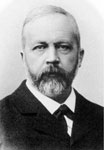Student Zone
Religious texts » Biblical Criticism » Source criticism
 Source criticism (sometimes referred to as literary criticism) tries to identify the sources upon which a text relies; it bears some relation to the stemmatic approach to textual criticism. Source criticism emerged out of work done on the Old Testament – particularly the book of Genesis – by French scholar Jean Anstruc (1684-1766) and later by German scholar Julius Wellhausen (1844-1918, pictured). Wellhausen's "Documentary hypothesis" tried to explain anomalies in the text of the Pentateuch (the first five books of the Bible, or the Torah: Genesis, Exodus, Leviticus, Numbers, Deuteronomy) in terms of there being four sources for the text, merged through a series of redactions (editings) into the work we have today. The sources Wellhausen suggested for the Pentateuch were:
Source criticism (sometimes referred to as literary criticism) tries to identify the sources upon which a text relies; it bears some relation to the stemmatic approach to textual criticism. Source criticism emerged out of work done on the Old Testament – particularly the book of Genesis – by French scholar Jean Anstruc (1684-1766) and later by German scholar Julius Wellhausen (1844-1918, pictured). Wellhausen's "Documentary hypothesis" tried to explain anomalies in the text of the Pentateuch (the first five books of the Bible, or the Torah: Genesis, Exodus, Leviticus, Numbers, Deuteronomy) in terms of there being four sources for the text, merged through a series of redactions (editings) into the work we have today. The sources Wellhausen suggested for the Pentateuch were:
• the Yahwist source (J) written c950 BC in the southern Kingdom of Judah, characterised by the use of the Hebrew name YHVH for an anthropomorphic God
• the Elohist source (E) written c850 BC in the northern Kingdom of Israel, characterised by the use of the Hebrew word Elohim (literally "Gods", plural) for God, a generic term, not a personal name, and used to describe a less anthropomorphic God.
• the Deuteronomist source (D) written c600 BC in Jerusalem during a period of religious reform, characterised by a preoccupation with covenant, the use of the phrase YHWH eloheinu (literally "the Lord our God") and God as the only king.
• the Priestly source (P) written c500 BC by Kohens (Jewish priests) in exile in Babylon, preoccupied with the status and role of the priests Aaron and his descendants and uses the name el-Shaddai for God before the revelation to Moses on Mount Sinai.
Wellhausen suggested that the Old Testament was compiled by redactors who used first JE, then JED, and finally JEDP, producing the final form of the Torah c450BC.
The documentary hypothesis has been refined many times, but is still the basis for scholarly understanding of the Pentateuch and some other parts of the Old Testament in most university theology departments.
The most famous application of source criticism to the New Testament began with Burnett Hillman Streeter's 1924 reconstruction of the relationship between the gospels and gospel-sources, sometimes referred to as the "two-source hypothesis". Streeter's argument was that Matthew and Luke depended on Mark's Gospel and a lost collection of sayings which he called "Q" (for Quelle, the German for "source"). Streeter's hypothesis has been much refined, but its central argument for the priority of Mark among the synoptic gospels (from the Greek sunopitkon - literally "seen together") and for the existence in some form, whether oral or written, of another common source for Matthew and Luke, are still largely accepted.


